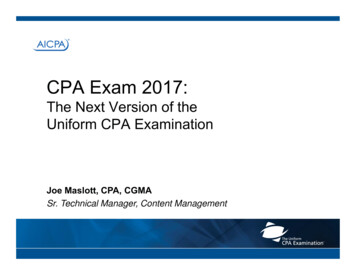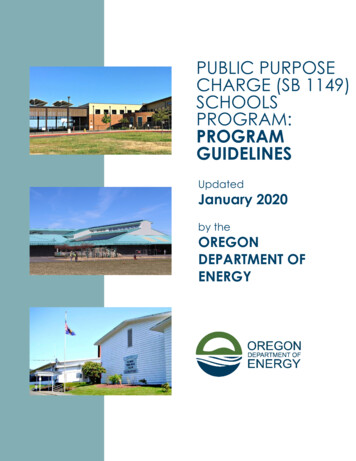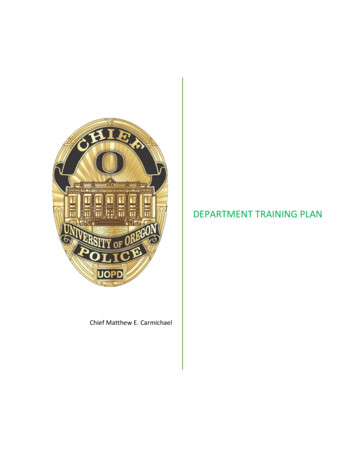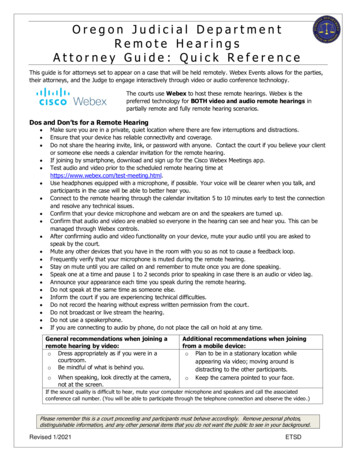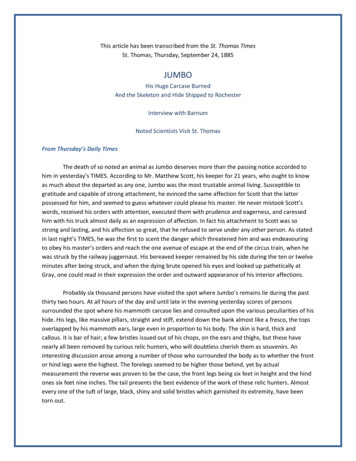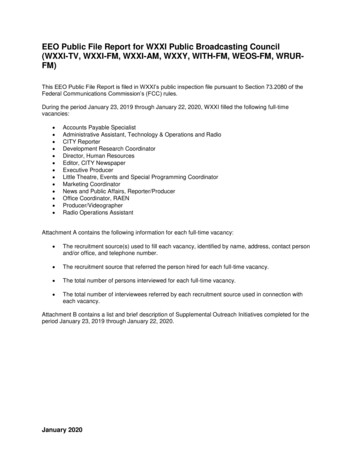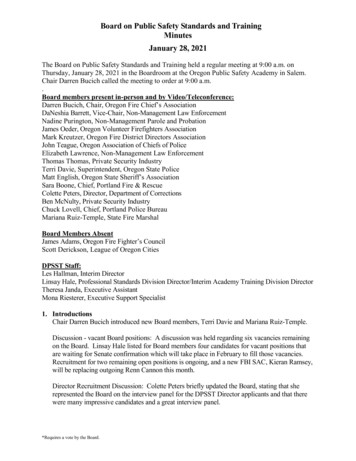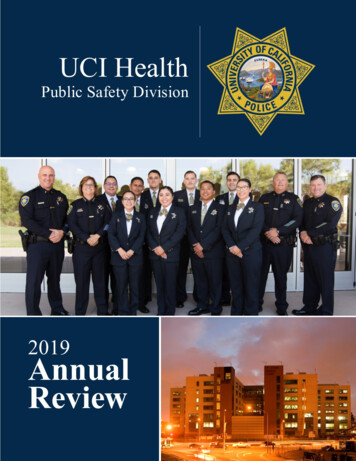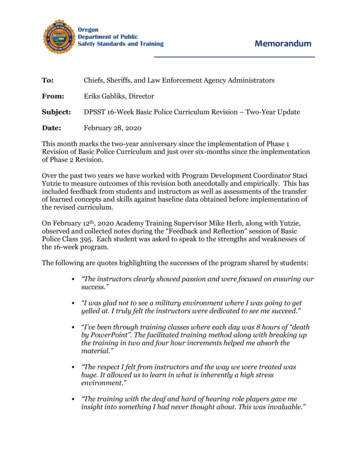
Transcription
OregonDepartment of PublicSafety Standards and TrainingMemorandumTo:Chiefs, Sheriffs, and Law Enforcement Agency AdministratorsFrom:Eriks Gabliks, DirectorSubject:DPSST 16-Week Basic Police Curriculum Revision – Two-Year UpdateDate:February 28, 2020This month marks the two-year anniversary since the implementation of Phase 1Revision of Basic Police Curriculum and just over six-months since the implementationof Phase 2 Revision.Over the past two years we have worked with Program Development Coordinator StaciYutzie to measure outcomes of this revision both anecdotally and empirically. This hasincluded feedback from students and instructors as well as assessments of the transferof learned concepts and skills against baseline data obtained before implementation ofthe revised curriculum.On February 12th, 2020 Academy Training Supervisor Mike Herb, along with Yutzie,observed and collected notes during the “Feedback and Reflection” session of BasicPolice Class 395. Each student was asked to speak to the strengths and weaknesses ofthe 16-week program.The following are quotes highlighting the successes of the program shared by students: “The instructors clearly showed passion and were focused on ensuring oursuccess.” “I was glad not to see a military environment where I was going to getyelled at. I truly felt the instructors were dedicated to see me succeed.” “I’ve been through training classes where each day was 8 hours of “deathby PowerPoint”. The facilitated training method along with breaking upthe training in two and four hour increments helped me absorb thematerial.” “The respect I felt from instructors and the way we were treated washuge. It allowed us to learn in what is inherently a high stressenvironment.” “The training with the deaf and hard of hearing role players gave meinsight into something I had never thought about. This was invaluable.”
“The scenarios and frag drills were awesome and getting to practice eachweek in the village what we learned in the classroom.” “I liked it when instructors made me think and articulate why I madecertain decisions.” “I liked the trivia days and this style of learning. I was able to learn somuch more in this type of format. More of this!” “I liked the physical training sessions and would like to see this extended.” “We learned much more about mistakes we made when we could see it onvideo. This should be expanded to other training areas.” “The DUII scenarios were awesome!”Students shared the following as to where we can improve: “We need more training on using the radio.” “Assigned groups should be mixed up so that we have the opportunity towork with more people from other departments.” “Defensive Tactics would get repetitive by the 7th or 8th session, we’d likemore variety or added skills taught.” “More night time training!” “The comments on EVOC were often based on subject observation. Itwould be nice to add objective criteria to the critique of skillsets here.” “More variety of scenarios.” “I’d like better feedback on where I can improve. The instructors were sonice and sometimes I thought they might be holding back” “Sometimes I would get conflicting guidance from instructors in EVOCand Building Search training.” “It would be great to pair officers with attorneys in the teaching of thelegal classes. The attorney can explain the law and the officer can thenteach us how to apply it.”Basic Police Curriculum Revision Outcomes – Two-Year UpdatePage 2 of 7
The following information has recently been shared by agency coordinators andinstructors: Instructors are surprised at the frequency and depth of knowledge and skillsshowing up in other training venues. We believe this is a result of the integrationof concepts and the programs intentional design. Instructors are impressed with the improved communication skills they are seeingin scenarios. Recruits are getting better at talking to people. Constituent agencies are commenting that recruits coming into field training arebetter prepared.The following information was provided by Staci Yutzie:Empirical Results:In addition to the anecdotal information above from students, instructors andconstituents, we have gather empirical data through contract with Dr. Stephen James atWashington State University. Dr. James helped to assess the transfer of the concepts andskills learned in training into video scenario application. This information has beencompared against baseline data prior to revision implementation and outline below.As part of the assessment, each recruit receives six video simulation scenarios in week 15of training. Three of the scenarios are tactical social interactions and can end either as apositive, neutral, or lethal encounter depending on the actions of the recruit.The simplified findings have been that: Fewer social interaction scenarios are ending with lethal force. We saw significant improvement in our Phase 1 cohorts with more scenarios beingdirected positive by the recruit. And the greatest significance was the improvement in recruits recognizing andrepairing an interaction that was heading negative due to their actions. In Phase 1we saw a 22% increase in repairing.Basic Police Curriculum Revision Outcomes – Two-Year UpdatePage 3 of 7
Preliminary Results – Social Interactions:771 of 946 Social Interaction scenarios ended without lethal force (81.5%). Further,Cohorts 1-3 (pre-Phase I) had more scenarios end with lethal force, on average 28.2%.Cohorts 4-9 (Phase I) had fewer scenarios end as a lethal encounter, on average 12.8%.Pre-Phase I28.2%Scenarios Ending with Lethal ForcePhase IChange12.8%15.4% fewer scenarios ended with lethal forceElements of positive social interactions are assessed to set these scenarios on a positiveor negative path. A recruit must attempt at least three of the five listed behaviors for apositive track. When considering if recruits attempt at least three of these behaviors,significant improvement is seen in Phase I cohorts (12.0% more scenarios directedpositive by recruit). These behaviors are specifically covered in the Phase I curriculum.Scenarios Directed Positive by Behavior Attempted by RecruitBehaviorPre-Phase IPhase IChange3 of 5 listed below51.7%63.8% 12.2Greets civilian73.5%86.6% 13.1Introduces self57.3%64.5% 7.3Explains purpose of encounter69.5%76.8% 7.3Demonstrates concern13.7%21.2% 7.6Reassures the civilian9.4%14.4% 5.0When recruits’ behaviors did turn scenarios negative at first, 22.6% more scenarios were“repaired” to end positively by Phase I recruits. These behaviors are specifically coveredin the Phase I curriculum.Basic Police Curriculum Revision Outcomes – Two-Year UpdatePage 4 of 7
Scenarios Repaired with Behaviors Attempted by RecruitBehaviorPre-Phase IPhase I1 of 5 listed below39.5%62.6%Acknowledges civilian’s emotions4.2%13.6%Empathizes6.0%11.7%Apologizes for inconvenience0.6%1.4%Tries to calm civilian26.5%36.4%Offers to help10.2%13.1%Change 23.1 9.3 5.7 0.8 9.9 2.8Through this revision we have redistributed our training hours, increasing hours for useof force, defensive tactics, and firearms, but simultaneously increasing attention onresiliency and competencies related to human interactions.One of these human interaction competencies we are measuring is the use of empathy.Empathy is one of the metrics identified in a study by Dr. James’ and his colleagues aboutofficer behaviors that are more likely to lead to a positive outcome in a given situation.In the below graph, the red bars on the left are three cohorts demonstrating empathy inthe tactical social interaction scenarios Pre Phase 1. The next three green bars are our firstcohorts going through Phase 1. Interestingly their empathy went significantly down afterthis was added to the program and our instructors were finding their way.The three green bars on the right shows empathy as demonstrated in three later Phase 1cohorts. And as you can see there has been significant improvement.Empathizes with the 0Basic Police Curriculum Revision Outcomes – Two-Year UpdatePage 5 of 7382383386388
Pre/Post byCohortPre-revision375376377Post Revision378380382383386388Cooperation dRepairedCooperation Compliance36%27%38%45%34%51%41%35%24%30%16%Basic Police Curriculum Revision Outcomes – Two-Year UpdatePage 6 of 4%16%DeadlyForce28%33%34%18%13%13%14%13%17%4%18%
Overall, there is great success to report at this stage of revision based on the informationlearned and provided in this memorandum.Phase 3 is preparing for implementation in early 2021 which will be followed by the finalphase of revision to update the Police Field Training Manual to ensure its alignment andfluidity with the Basic Academy.In closing we wanted to thank the dozens of stakeholders who have been active in thecurriculum work groups that enabled Phase I and Phase 2 of the 16-Week Basic PoliceCourse to be reviewed from top to bottom and updated to meet your needs.I would be remiss if I didn’t also recognize the work of DPSST’s Center for PolicingExcellence for their leadership of this review and our talented staff for their countlesshours of hard work to implement the changes necessary to update Oregon’s Basic PoliceCourse to meet the needs of our stakeholders and the communities they serve.Basic Police Curriculum Revision Outcomes – Two-Year UpdatePage 7 of 7
Safety Standards and Training Memorandum Oregon Department of Public To: Chiefs, Sheriffs, and Law Enforcement Agency Administrators From: Eriks Gabliks, Director Subject: DPSST 16-Week Basic Police Curriculum Revision – Two-Year Update Date: February 28, 2020 This month marks the

